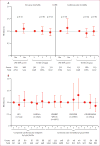Relations between lipoprotein(a) concentrations, LPA genetic variants, and the risk of mortality in patients with established coronary heart disease: a molecular and genetic association study
- PMID: 28566218
- PMCID: PMC5651679
- DOI: 10.1016/S2213-8587(17)30096-7
Relations between lipoprotein(a) concentrations, LPA genetic variants, and the risk of mortality in patients with established coronary heart disease: a molecular and genetic association study
Abstract
Background: Lipoprotein(a) concentrations in plasma are associated with cardiovascular risk in the general population. Whether lipoprotein(a) concentrations or LPA genetic variants predict long-term mortality in patients with established coronary heart disease remains less clear.
Methods: We obtained data from 3313 patients with established coronary heart disease in the Ludwigshafen Risk and Cardiovascular Health (LURIC) study. We tested associations of tertiles of lipoprotein(a) concentration in plasma and two LPA single-nucleotide polymorphisms ([SNPs] rs10455872 and rs3798220) with all-cause mortality and cardiovascular mortality by Cox regression analysis and with severity of disease by generalised linear modelling, with and without adjustment for age, sex, diabetes diagnosis, systolic blood pressure, BMI, smoking status, estimated glomerular filtration rate, LDL-cholesterol concentration, and use of lipid-lowering therapy. Results for plasma lipoprotein(a) concentrations were validated in five independent studies involving 10 195 patients with established coronary heart disease. Results for genetic associations were replicated through large-scale collaborative analysis in the GENIUS-CHD consortium, comprising 106 353 patients with established coronary heart disease and 19 332 deaths in 22 studies or cohorts.
Findings: The median follow-up was 9·9 years. Increased severity of coronary heart disease was associated with lipoprotein(a) concentrations in plasma in the highest tertile (adjusted hazard radio [HR] 1·44, 95% CI 1·14-1·83) and the presence of either LPA SNP (1·88, 1·40-2·53). No associations were found in LURIC with all-cause mortality (highest tertile of lipoprotein(a) concentration in plasma 0·95, 0·81-1·11 and either LPA SNP 1·10, 0·92-1·31) or cardiovascular mortality (0·99, 0·81-1·2 and 1·13, 0·90-1·40, respectively) or in the validation studies.
Interpretation: In patients with prevalent coronary heart disease, lipoprotein(a) concentrations and genetic variants showed no associations with mortality. We conclude that these variables are not useful risk factors to measure to predict progression to death after coronary heart disease is established.
Funding: Seventh Framework Programme for Research and Technical Development (AtheroRemo and RiskyCAD), INTERREG IV Oberrhein Programme, Deutsche Nierenstiftung, Else-Kroener Fresenius Foundation, Deutsche Stiftung für Herzforschung, Deutsche Forschungsgemeinschaft, Saarland University, German Federal Ministry of Education and Research, Willy Robert Pitzer Foundation, and Waldburg-Zeil Clinics Isny.
Copyright © 2017 Elsevier Ltd. All rights reserved.
Figures



Comment in
-
Lipoprotein(a) and cardiovascular mortality: mystery still unsolved.Lancet Diabetes Endocrinol. 2017 Jul;5(7):489-490. doi: 10.1016/S2213-8587(17)30101-8. Epub 2017 May 26. Lancet Diabetes Endocrinol. 2017. PMID: 28566219 No abstract available.
References
-
- Writing Group M. Mozaffarian D, Benjamin EJ, et al. Heart disease and stroke statistics—2016 update: a report from the American Heart Association. Circulation. 2016;133:e38–60. - PubMed
-
- Lamina C, Kronenberg F. The mysterious lipoprotein(a) is still good for a surprise. Lancet Diabetes Endocrinol. 2013;1:170–72. - PubMed
-
- Danesh J, Collins R, Peto R. Lipoprotein(a) and coronary heart disease. Meta-analysis of prospective studies. Circulation. 2000;102:1082–85. - PubMed
-
- Kamstrup PR, Benn M, Tybjaerg-Hansen A, Nordestgaard BG. Extreme lipoprotein(a) levels and risk of myocardial infarction in the general population: the Copenhagen City Heart Study. Circulation. 2008;117:176–84. - PubMed
Publication types
MeSH terms
Substances
Grants and funding
LinkOut - more resources
Full Text Sources
Other Literature Sources
Miscellaneous

